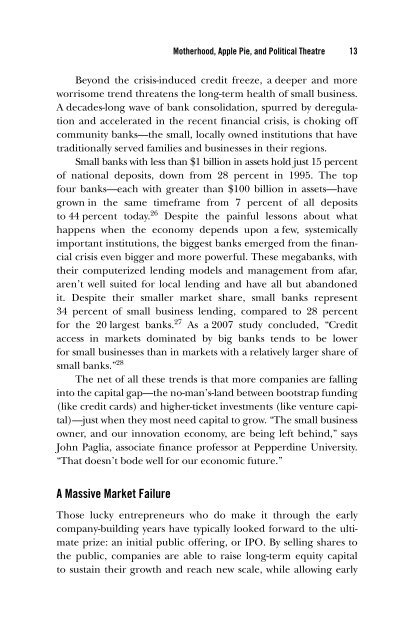3c hapter - Index of
3c hapter - Index of
3c hapter - Index of
Create successful ePaper yourself
Turn your PDF publications into a flip-book with our unique Google optimized e-Paper software.
Motherhood, Apple Pie, and Political Theatre 13<br />
Beyond the crisis- induced credit freeze, a deeper and more<br />
worrisome trend threatens the long- term health <strong>of</strong> small business.<br />
A decades- long wave <strong>of</strong> bank consolidation, spurred by deregulation<br />
and accelerated in the recent fi nancial crisis, is choking <strong>of</strong>f<br />
community banks—the small, locally owned institutions that have<br />
traditionally served families and businesses in their regions.<br />
Small banks with less than $1 billion in assets hold just 15 percent<br />
<strong>of</strong> national deposits, down from 28 percent in 1995. The top<br />
four banks—each with greater than $100 billion in assets—have<br />
grown in the same timeframe from 7 percent <strong>of</strong> all deposits<br />
to 44 percent today. 26 Despite the painful lessons about what<br />
happens when the economy depends upon a few, systemically<br />
important institutions, the biggest banks emerged from the fi nancial<br />
crisis even bigger and more powerful. These megabanks, with<br />
their computerized lending models and management from afar,<br />
aren’t well suited for local lending and have all but abandoned<br />
it. Despite their smaller market share, small banks represent<br />
34 percent <strong>of</strong> small business lending, compared to 28 percent<br />
for the 20 largest banks. 27 As a 2007 study concluded, “Credit<br />
access in markets dominated by big banks tends to be lower<br />
for small businesses than in markets with a relatively larger share <strong>of</strong><br />
small banks.” 28<br />
The net <strong>of</strong> all these trends is that more companies are falling<br />
into the capital gap—the no-man’ s- land between bootstrap funding<br />
(like credit cards) and higher- ticket investments (like venture capital)—just<br />
when they most need capital to grow. “The small business<br />
owner, and our innovation economy, are being left behind,” says<br />
John Paglia, associate fi nance pr<strong>of</strong>essor at Pepperdine University.<br />
“That doesn’t bode well for our economic future.”<br />
A Massive Market Failure<br />
Those lucky entrepreneurs who do make it through the early<br />
company- building years have typically looked forward to the ultimate<br />
prize: an initial public <strong>of</strong>fering, or IPO. By selling shares to<br />
the public, companies are able to raise long- term equity capital<br />
to sustain their growth and reach new scale, while allowing early
















